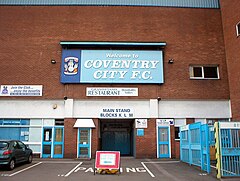Highfield Roadwas afootballstadiumin the city ofCoventry,England.It was the home ground forCoventry Cityfor 106 years.
Highfield Road | |
 Entrance, 22 April 2004 | |
 | |
| Location | Hillfields,Coventry,England |
|---|---|
| Coordinates | 52°24′43″N1°29′24″W/ 52.41194°N 1.49000°W |
| Owner | Coventry City |
| Capacity | 23,489 (as all-seater) |
| Surface | Grass |
| Construction | |
| Opened | 1899 |
| Closed | 30 April 2005 (last game) |
| Demolished | 2006 |
| Tenants | |
| Coventry City(1899–2005) | |

History
editIt was built in 1899 in the Hillfields district, close to the city centre, and staged its final game on 30 April 2005 when Coventry City beatDerby County6–2 in theFootball League Championshipwith the last goal appropriately being scored byAndy Whing,a product of Coventry City's youth academy. A concert by pop starElton Johnwas held at the stadium afterwards. The club then moved to theRicoh Arena,atFoleshillin the north of the city.
Highfield Road had one of the largest playing surfaces in the English leagues and was the English league's firstall-seater stadium(the first all-seater in the UK wasClydebank'sKilbowie Park). The all-seater policy introduced byJimmy Hillwas later abandoned whenLeeds Unitedfans tore-out several hundred seats after losing their First Division game to Coventry City 4–0 in 1981, only months after the seats had been installed.[1]
Standing accommodation returned to Highfield Road in 1983, but it became all-seater once again eleven years later when all top division clubs were required to have all-seater stadiums as a result of theTaylor Report,which was the response to theHillsborough disasterof 1989.[2]
The stadium's record attendance was 51,455 when Coventry City played their West Midlands rivalsWolverhampton Wanderersin a Football League Division 2 game in 1967. However, after it was converted to an all-seater stadium for the second time in the mid-1990s, its maximum capacity was 23,489 at the time of its closure, and all of the pre-1990 seats had been replaced in 1995. The stadium had by then been well-developed with one corner filled to provide a more modern look and feel.
However, it lacked facilities compared to the new stadia of similar-sized clubs, which was one of the main causes of the move to theRicoh Arena.Another reason for relocation was that parking facilities in the local area were inadequate. When the stadium was first given the go-ahead in 1999, it had been planned to build a 45,000-seat stadium as part of England's bid to host the2006 World Cup.However, England's failure to win the bid to host the tournament – combined with Coventry's relegation in 2001 – saw the stadium's capacity scaled down.[3]
Demolition work began in February 2006 and was completed by the end of the following month.
Post-stadium housing development
editThe site of the stadium was regenerated byGeorge Wimpey plcto provide housing on the areas which were originally the car parks and stands. The area which was the playing surface was relaid with grass so that the local children can continue the tradition of playing football on that space.
- Redevelopment
-
New buildings around the site of the former football pitch.
(photo April 2007) -
View eastward along Thackhall Street in April 2007; the stadium was on the right and a car park was on the left.
References
edit- ^Swain, Martin (19 September 1981)."Sky Blues sit up..."Sports Argus.Archivedfrom the original on 26 December 2023.Retrieved14 September2023.
- ^"Take a tour around the home of the Sky Blues".BBC.October 2003.Archivedfrom the original on 11 October 2011.Retrieved25 February2011.
- ^Peel, Colin (November 2001)."Better the devil you know".When Saturday Comes.Archivedfrom the original on 5 November 2011.Retrieved25 February2011.